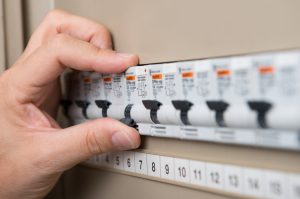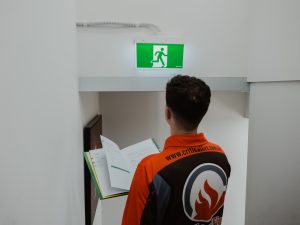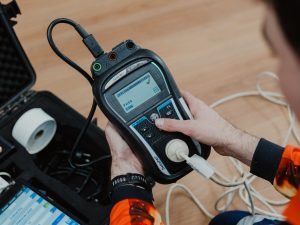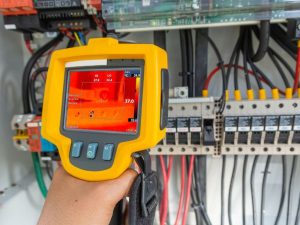Electrical Safety Compliance
Servicing and Maintenance to AS 3760, AS 2293.2 and AS 1851
Keep people safe, reduce fire risk, stay compliant
Our Electrical Division delivers testing and inspection programs that support your fire protection and workplace safety obligations. We plan risk-based schedules, complete the tests with minimal disruption, and give you clear records that stand up to scrutiny
Electrical Safety Compliance
 Reduce shock risk and stay compliant with professional inspection, testing and tagging of residual current devices (RCDs) and portable electrical equipment to AS/NZS 3760. We plan intervals to suit your environment and usage, keep clear records, and fix issues fast. RCD testing is required by WHS Laws and is often requested by insurers.
Reduce shock risk and stay compliant with professional inspection, testing and tagging of residual current devices (RCDs) and portable electrical equipment to AS/NZS 3760. We plan intervals to suit your environment and usage, keep clear records, and fix issues fast. RCD testing is required by WHS Laws and is often requested by insurers.
What we test
Fixed RCDs at distribution boards and combination outlets
Portable RCDs and safety switch adaptors
What we do
Visual inspection for damage and signs of deterioration, labelling, secure installation
RCD push test for mechanical release
RCD timed test using a calibrated test machine
Tagging, asset register updates and digital compliance reports including QR code tracking
Defect notifications with clear rectification options
Test intervals
We schedule to AS/NZS 3760 based on risk and environment. Typical programs include:
Offices and low-risk areas: 6-monthly visual inspection and push test.
Workshops, kitchens, hostile or rough-use areas: annual visual inspection, push test and timed test using a calibrated test machine
Construction and demolition sites: programs aligned to AS/NZS 3012 (more frequent testing)
Outcome
Lower electrical risk, compliance with WHS obligations fewer surprises and records that stand up to scrutiny.
 Emergency and exit lighting guides people to safety during emergencies, whether you have mains power or not. We keep your system ready to perform with routine service to AS 2293.2, clear records and fast rectification.
Emergency and exit lighting guides people to safety during emergencies, whether you have mains power or not. We keep your system ready to perform with routine service to AS 2293.2, clear records and fast rectification.
What we service
- All types of exit lights and emergency lights
Self-contained emergency luminaires and exit signs (and single point systems)
Central battery systems and monitoring panels
Test switches, test timers, circuits and labelling
What we do
Six-monthly physical inspection to AS 2293.2
Annual functional tests, integrity checks, discharge testing and system survey for changes to the building or use
End of life lighting replacements following failures during discharge testing.
Baseline data capture at commissioning, logbook updates and digital asset registers
Lux and placement verification against AS 2293.1 where required, especially after alterations
Fault finding, repairs, replacements and upgrades with minimal disruption
Outcome
Reliable egress lighting, fewer defects at inspection time and strong compliance across your site.

Reduce shock and fire risk, meet WHS duties and keep clean records with Portable Appliance Testing (Test and Tag) to AS/NZS3760.AS/NZS 3760.
What we test
Appliances, extension leads and cords, power boards, chargers and cables.
What we do
Visual inspection for damage, suitability and labelling
Electrical tests: earth continuity, insulation resistance and polarity where applicable
Tagging, barcoding and a digital asset register with photo evidence
Clear pass or fail reports, defect notifications and rectification options
Typical retest intervals
We set schedules to AS/NZS 3760 based on risk and environment:
Offices and low-risk areas: appliances every 12 months.
Workshops, manufacturing and aggressive environments every 6 months
Construction and demolition: programs aligned to AS/NZS 3012
Outcome
Lower electrical risk, fewer surprises at audit time and records that stand up to scrutiny.

Find faults before they fail. Our non-intrusive infrared scans identify overheating connections and hotspots in live electrical and mechanical equipment so you can fix issues early, reduce fire risk, meet insurance obligations and prevent downtime.
What we test
Main switchboards, distribution boards and control panels
MCCs, VSDs, UPS and power factor correction units
Busbars, cable terminations and breakers
Critical motors, bearings and mechanical equipment
How we work
Pre-scan safety check and load verification so equipment is operating under normal conditions
Live thermal imaging using calibrated cameras with visual images for reference
Delta-T measurements, severity ratings and immediate escalation of critical defects
Clear PDF report with annotated thermograms, root-cause guidance and prioritised rectification actions
Follow-up verification scans after repairs
Typical intervals
Annually for most commercial and industrial sites
Six-monthly for high-risk environments or where insurers require it
After major electrical works or recurrent faults
Why it helps
Reduces fire risk from loose, overloaded or deteriorated connections
Minimises unplanned outages and repair costs
Supports WHS risk management and insurer expectations
No shutdown required in most cases, minimal disruption
Ready to feel confident about fire safety?
Book your free Fire Safety Assessment. Get a clear plan aligned to AS 1851 with simple next steps.
